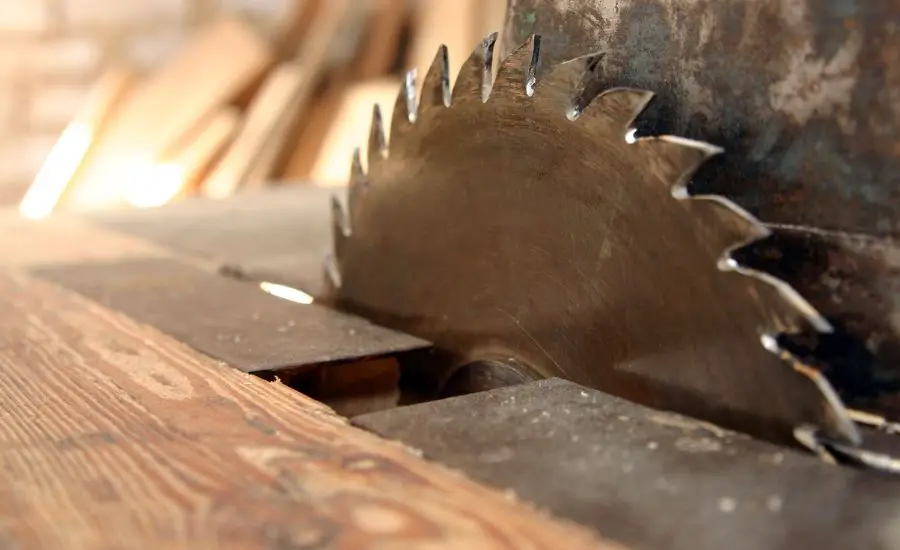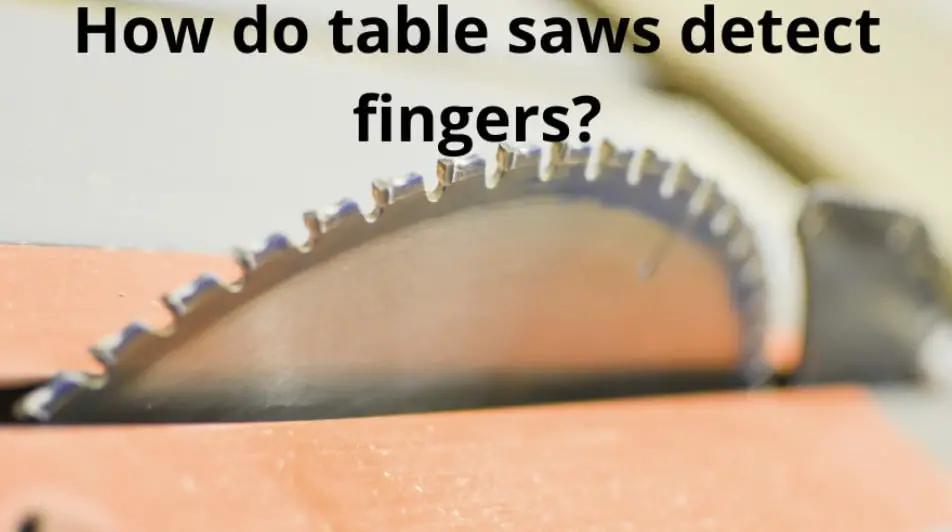Let’s be honest. There are 2 main reasons why you might be here.
- You’re understandably scared that a table saw will cut your finger off;
- You’re simply a person curious about how a table saw operates.
But seriously, the times when contact with the blade could lead to losing fingers, are done. Now engineers know how to make table saws safer. The safety of your fingers is the main topic of the following text.
In this article, you’ll find out how do table saws detect fingers and even more.

SawStop technology keeps your pinky safe
SawStop is a system that allows the blade to detect a finger and stop the blade. The way this technology works is quite complicated. The technology of these table saws is called Active Injury Mitigation (AIM) System. The whole process takes 4 steps:
Detection
- The blade carries a small electrical signal.
- The human body carries conductive properties. When our skin contacts the blade, our charge influences the signal to the table saw.
- The safety system activates when this signal is changed.
Stop
- An aluminum brake springs into the path of the blade.
- The brakes make the blade stop completely. The motor then loses its power.
Drop
- As the blade comes to a stop, the blade is driven beneath the SawStop table, removing the risk of subsequent contact.
- The whole process takes less than 5 milliseconds. Table saws work so fast that a human won’t even be able to react fast enough and understand what happened.
Reset
- The table saw needs resetting after finger detection, as the power is shut automatically. Simply replace the brake cartridge, and that table saw is back on track. Oh, and check the blade, just in case. Sometimes the brake is so strong that it damages the blade.
- The entire process of resetting takes approximately ninety seconds.
This safety technology is very effective. In some accidents, though, you might get a small cut if you go fast and directly for the blade.
But it will always save you from serious injuries and prevent accidents.
The question of how do table saws detect fingers is pretty much answered. It’s all because the table saw recognizes electricity within humans. But there might be some peculiarities surrounding these questions you might take a look at.

Checking if SawStop works
Apropos, how do you get if your table saw is even in the detection mode? Simple. When you turn on the saw blade, the red light flashes. It indicates that the system is working normally.
If you want to test the Active Injury Mitigation System, try shoving a hot dog into the moving blade cautiously. A hot dog is made of flesh, just like us, so a working SawStop table should stop working as if it touched your skin.
The table saw also has many modes, like bypass mode (brake is not fired in any way), standby mode (allows the power to stay when the blades stop), and others. You can find more information on those in the manual for your table saw.
Can you install SawStop onto any saw?
There are 2 main kinds of sawblades: the traditional ones and those that have SawStop preinstalled.
Even if the blade is traditional, you can still probably install a SawStop system on it. You just need to buy the equipment separately and then install the thing.
Please remember to check the compatibility. In some cases, the system is too old to install this finger detection technology. For example, if the blade is non-conductive, it won’t support the technology (SawStop runs on conductivity mechanics).
It is widely advised to buy a table saw with SawStop’s AIM preinstalled. Redesigning your old table saw would probably take more money and definitely more energy. It will need an overhaul.

Other safety technologies
SawStop is not the only safety technology a saw can have. There were many safety features invented before and will be after, sometimes for a small price.
The list includes blade guards, switches, sticks, and other safety measures.
Don’t be overzealous. Some sites say that traumas with a table saw blade happen every 9 minutes. There are over 30 thousand table saw injuries occurring every year. That’s a curt, powerful tool. So please check these options for safety reasons.
Sensors
SawStop is the only thing that helps detect flesh. Though this system is the market leader right now, you might need an alternative.
Bosch REAXX was one of the first attempts to recreate the technology works SawStop. It also operates by detecting electric signals in humans. Its advantage over SawStop is the ability to retract the blade without damaging it. At least the company claims it can do so.
Grizzly Industrial offers similar flesh-sensing technology. This saw features a highly efficient dust collection system and a riving knife.
Altendorf Group is one of the less famous alternatives. It operates not on electric current but on optical contact. Its 2 small cameras detect the proximity of an arm and a blade, and retract the saw when it gets too close. The retraction is slower than SawStop’s aim but saves from major accidents.
Magnetic switch
The magnetic switch won’t detect fingers. But what it does is also important.
Firstly, it prevents the motor from overloading. Overloading leads to overheating and dramatically shortens the “lifespan” of the motor.
Secondly, it can set the base saw into an “off” position during a power outage. Imagine being in the middle of adjusting or spinning the blade, and the power comes back on. With a magnetic switch, the saw will be automatically set to the “off” position when it loses power.
Push stick
A push stick is a traditional safety feature. A push stick comes in handy when you need to slide the to-be-cut material through the spinning blade.
If you put your fingers close to a table saw, you asking for a major, serious injury here.
That’s when you need a push stick, serving as an extension of your hand. No tests, no flesh sensing technology or brake cartridges – so simple but so effective.

Riving knife
The riving knife is another safety feature. It is attached to table saws. It moves in unison with the blade of a table saw and prevents kickbacks and bindings. Kickback is an instance when the material is jammed under the table saw. The material then may be thrown into an operator with inertia, which is quite dangerous.
It should be noted that your table saw needs a riving knife if you cut hard materials.
The riving knife has an alternative, a splitter. The main difference is that the splitter stands not in that back, but in front of a table saw and has teeth.
Blade guards
A blade guard is a must-have in the saw table world. It creates a physical barrier between fingers and a blade, not allowing physical contact.
For certain cuts, the removal of blade guards is necessary. For this reason, people of the past removed the guard and damaged their fingers. But with the rise of technology, the removal of blade stops is less necessary.
The modern blade guards often come in transparent form and don’t interfere with the work of a table saw.
A blade guard offers other safety features. Blade guards help collect dust and prevent woodchips from falling on your skin and eyes.
Out of the stated safety measures, blade guard seems to be the most prominent and general. Your table saw probably needs it. Even table saws running on AIM often come with a blade guard, just in case.

FAQ
There are some additional questions as to How do table saws detect fingers. Let’s see what is left on our SawStop table saws.
How do the new table saws detect fingers?
The newer table saws usually come with finger detection technology. When the human flesh comes in contact with the blade, it gets a signal from the electrical charge within us. The aluminum brake responds by blocking the current signal to the blade within milliseconds. Then the blade stops.
There are some less popular sensing technologies, like using cameras with optical detection or sound ways to identify fingers.
How does a SawStop know it’s a finger?
The Sawstop table knows it’s our finger and not metal because the body carries electrical signals, and the blade senses skin, a natural electrical conductor. Sawstop table saws need just the slightest current signal to stop the blade.
It should be noted that SawStop doesn’t really differentiate between different kinds of flesh. It will recognize both a finger and a hotdog as part of a human body and stop working. Table saws probably require more time to figure that out.
How does the saw tell the difference between your finger and wood?
When cutting wood, the saw recognizes only the difference in conductivity between wood and fingers. Our body is a natural electrical conductor, so our conductivity is noticeable. That’s the difference.
The modern table saw will continue cutting wood, but won’t allow a finger to contact the blade. SawStop makes table saws safer.
What is the most common accident caused by table saws?
A table saw leads to serious injuries in many accidents in general. Usually, it’s the laceration of fingers or hands. Over 30 thousand saw injuries happen each year. A good safety system that allows the table saws to detect fingers is what stands between you and a bad injury
Conclusion
Now you know how do table saws detect fingers. Stay safe! Being cautious helps prevent accidents.
Look for safe modern table saws and have a good working day!
I am Tony Darryl, a woodworker and handyman with over 8 years of experience. My years of work have allowed me to have knowledge that I can share with others. I will tell you in detail about this or that process because it is important to do it safely for you.
Carving, working with different types of blades, metal cutting, and woodworking – this is what I specialize in, and I will help you understand these processes.



